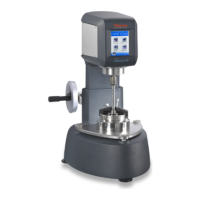
Do you have a question about the Thermo Scientific HAAKE Viscotester iQ and is the answer not in the manual?
| Connectivity | USB, Ethernet |
|---|---|
| Shear Rate Range | 0.1 to 1000 s⁻¹ |
| Software | RheoWin |
| Accuracy | ±1% of reading |
| Repeatability | ± 0.5 % |
| Display | Touchscreen |
| Power Supply | 100 - 240 V, 50/60 Hz |
| Viscosity Measurement | Dynamic Viscosity |
Lists other documents provided for use with the HAAKE Viscotester iQ.
Details cautions, warnings, and symbols used in the manual for safe operation.
Provides contact information for technical support and sales worldwide.
Describes the company's Quality Management System and certifications.
Outlines warranty terms and recommended service intervals for the instrument.
Introduces the HAAKE Viscotester iQ as a versatile rheometer for quality control.
Describes the rheometer's design, flexibility, and models (ball-bearing vs. air-bearing).
Highlights the user-friendly touchscreen interface and ease of use.
Focuses on the automated features and operator guidance.
Lists key technical features, motor capabilities, and connectivity options.
Specifies the necessary bench space and stability for instrument placement.
Details the requirements for electrical power connection, including voltage and grounding.
Outlines air quality, pressure, and consumption requirements for the air-bearing model.
Lists the required environmental conditions for proper instrument operation.
Specifies hardware and OS requirements for operating the HAAKE RheoApp and RheoWin software.
Instructions on how to carefully unpack the instrument and check for damage.
Procedures to follow if the instrument is damaged during transit.
Details the items included in the standard delivery package.
Information on setting up the instrument when using a lab stand.
Details for installing the instrument head in custom setups.
Step-by-step guide for physically setting up the HAAKE Viscotester iQ instrument.
Instructions for powering on the instrument and its initialization process.
Explains how the instrument identifies connected temperature modules.
Procedures for mounting, dismounting, and cleaning measuring geometries like rotors and cups.
Operating the lift mechanism and adjusting the container holder.
Procedures for setting up different geometries and measuring gaps.
Using the lab stand for specific measurement setups.
Navigating the touchscreen UI and various menus.
Comparison of different temperature modules based on features and specifications.
Details on the TM-PE-C module, its working principle, and performance.
Information on the TM-PE-P module, including its working principle and performance.
Covers TM-LI series modules, their use with circulators, and specifications.
Detailed technical specifications for the main rheometer unit, including motor and dimensions.
Mechanical properties of the optional lab stand.
Mechanical and electrical properties of the power supply unit.
Lists minimum and maximum temperature values for various modules.
Details on temperature modules (TM-PE-C, TM-PE-P, TM-LI-Cxx) and their contents.
Information about the tool for calibrating temperature offsets.
Information on available hoods for temperature modules and their usage.
Lists available measuring geometries, adapters, and calibration tools.
Details on software options and network connectivity accessories.
Lists other available accessories like screen protectors and keyboards.